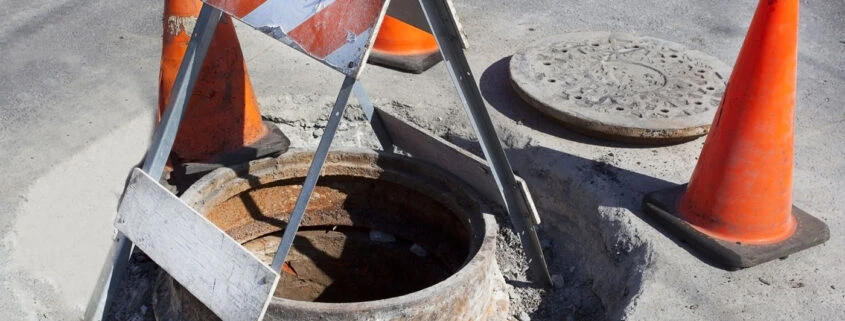Do You Know the Standards for OSHA and Confined Spaces?
In today’s construction industry, safety on the job is often at forefront of our minds; largely due to the dangerous nature of our work. While tremendous focus will rightfully continue to be placed on injuries and fatalities that arise from the construction industry’s biggest hazards (falls, electrical, struck-by and caught-in-between accidents), we cannot lose sight of the dangers around us that may be less obvious, hidden, or even invisible.
When considering confined spaces and the immediate threats they pose on the job, it is easy to underestimate the dangers associated with entering or working inside of them. Reported deaths related to confined space accidents are generally few and far between; making it even easier for workers to miscalculate a potential for danger. While knowledge of a lack of (frequent) workplace accidents can lead to a false sense of security with a worker, employers must be diligent in ensuring they don’t fall victim to the same “It won’t happen to me” type of mentality.
Prior to the announcement of OSHA’s new Confined Space Standard, the only requirement for the construction industry as it related to confined spaces was training. Even with training as a requirement for employers across the general industry, the injuries and fatalities associated with confined space work in construction continue to occur. After several years of tallying injury and fatality statistics related to confined space operations failed to indicate a positive correlation between safety training and the reduction of workplace accidents. OSHA concluded that a change was warranted for the construction industry. This change, which is now fully outlined in Title 29 of the Code of Federal Regulations, Part 1926 (29 CFR 1926) Subpart AA, highlights several new responsibilities for employers; some of which will apply regardless of whether work is being performed in the construction industry or general industry.
The Big Picture
The existing confined space standard only requires employers to train their workers who will be exposed to hazards. This effectively exempts employers from having to possess a lot of knowledge about confined space safety. This could include knowledge of requirements for confined space access / egress, testing of atmospheric conditions and methods for worker rescue or retrieval.
The new standard will require employers to better educate themselves before allowing their employees to work in confined spaces. When it comes to safety on the job as it relates to accident prevention, employers will not have the luxury of claiming ignorance to the rules.
Under 29 CFR 1926 Subpart AA, employers must be cognizant of the types of confined spaces their workers are exposed to (manhole, silo, pipe, tunnel, trench, etc.), the potential hazards inside, methods for eliminating those hazards and the applicable rescue procedures. It is also now incumbent upon employers to determine the type of training their employees receive as it relates to confined space operations. This will be one of the greatest areas of vulnerability for employers regarding this new standard, as employers have no one with whom they can share responsibility for work-related accidents. Employers can no longer just purchase training materials for confined space safety, throw a group of employees into a room for a day to watch videos and be satisfied that they have adequately prepared those employees for the hazards that can potentially be encountered in their work.
Regardless of whether the training given to employees is good, bad, compliant, noncompliant, or anywhere in between, ultimately, the responsibility (and liability) now lies with the employer to ensure the correct type of training is delivered to their workers. General confined space training may or may not be sufficient for a company’s needs.
So, what’s next and what does this mean for my company?
The new confined space standard became effective for all employers on August 3, 2015. There is no grace period for compliance with this new standard. Employers need to be aware of this for confined space terminology, their new responsibilities under the standard and any updates or changes to their company safety documentation. This documentation could include corporate safety manuals, emergency procedures or training materials.
Those who are responsible for safety on construction job sites understand that as a project evolves, the conditions and hazards on the job change along with it. One segment of a job may introduce a vault, pit or boiler as a confined space where another job segment will introduce an excavation that’s over six feet in depth. One confined space may require an entry permit or specialized equipment where another does not. Employers will now have the challenge of not only selecting the proper training for their workers but also ensuring that the training they select encompasses all potential hazards and requirements for the work to be performed. In many circumstances, this could include supplemental training for a job site’s foremen, supervisors or competent persons in rescue procedures / equipment, ladders, trench safety or even fall protection safety.
Understanding different types of confined spaces, the hazards associated with confined spaces and the legal requirements that bind employers is the key to ensuring compliance with OSHA’s new standard for Confined Spaces in Construction. Educating your employees will go a long way towards keeping them safe and will help to protect your company against regulatory citations resulting from noncompliance.
Contact HB NEXT for more information concerning this standard. HB NEXT is your #1 partner for construction service support. Did you know HB NEXT offers Legal Services to keep your company out of the courtroom with violations?
By: Ryan Boling, HB NEXT



